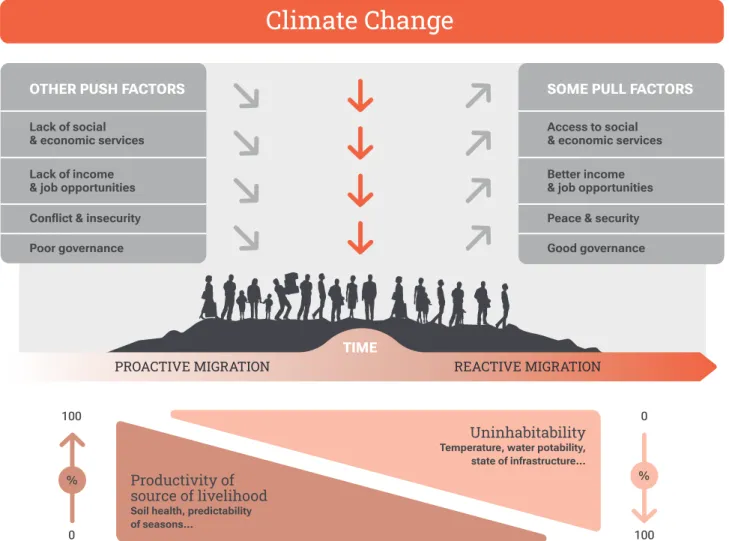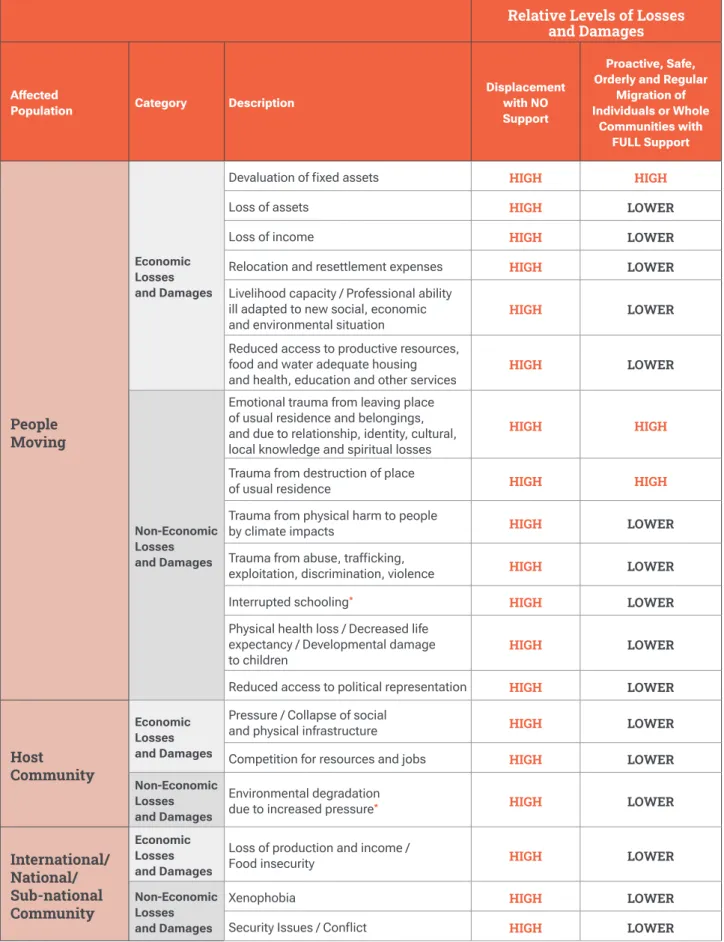Based on the experiences of Caritas' National Member Organizations, this report provides an overview of the difficulties faced by people displaced within and across national borders due to climate change. Funds are also urgently needed to address the loss and damage caused by migration due to climate change.
Mostly rural-rural or rural-urban and within borders 26
Too much hardship: human rights violation and losses
With a largely coastal population, the Oceania region is highly vulnerable to displacement due to climate change. In some areas, people are affected by both conflict and environmental degradation due to climate change. Once they leave, individuals displaced by climate change may find themselves traveling alongside people for a variety of reasons, using the same routes and modes of transportation.
Some people who migrate due to climate change decide to return to their place of origin. Some traditional leaders do not allow burial outside of ancestral land, adding to the tragedy when a person who is en route to climate change dies.

A holistic approach is required for each stage
Plan together and value traditional solutions 43
Make full use of existing planning instruments 47
Caritas members in Colombia, Guatemala, Oceania (BOX 1) and Mozambique (BOX 5) all point to the importance of improving data collection on climate change displacement. Indeed, reliable data and modeling are essential to understand the issue of displacement due to climate change and to make predictions for the future. Governments must urgently increase their efforts to collect data on displacement due to climate change.
The governments of many of the countries most vulnerable to climate change struggle to provide services to their populations at large. At the same time, most countries struggling to care for people on the move due to climate change account for very little of the emissions that cause the problem.
Large investments are required in countries
53 52 DISPLACED FROM A DIFFERENT CLIMATE | Caritas Voices: protecting and supporting people on the move 4 / GREATER INCREASE FUNDING TO ENSURE MIGRATION WITH DIGNITY 53. The vast majority of displacements due to climate change occur in lower- and middle-income countries, including is the group of least developed countries (LDCs) whose economies and tax revenues, both national and local, are already adversely affected by climate change. In fact, there is a high correlation between climate vulnerability and debt2 and many of the affected countries have very little fiscal space and institutional capacity to deal with the increased challenges.
For example, the 46 LDCs—including eight small island states (SIDS)—which account for many of the most climate-vulnerable countries, are responsible for only 3.3% of total greenhouse gas (GHG) emissions.3 Expect these climates. vulnerable countries to shoulder the effects of a problem they did not historically cause and to which they contribute minimally today is neither feasible nor fair. 3 https://www.undp.org/publications/state-climate-ambition-snapshots-least-developed-countries-ldcs-and-small-island-developing-states-sids.
Dealing with the consequences of a problem
Major investments in social and physical infrastructure are needed to accommodate, protect, encourage and integrate people on the path to the negative impacts of climate change, both today and tomorrow. 1 https://www.un.org/en/desa/economic-and-political-costs-population-displacement-and-their-impact-sdgs-and.
Funds need to make it to where they are needed 57
55 54 ANXIETY OF A CHANGE OF CLIMATE | Caritas Voices: Protection and support for people on the move 4 / DIGNITY INCREASE FUNDING TO ENSURE MIGRATION WITH DIGNITY. Of the funds raised in 2020, only a third was spent on adaptation, while the rest was dedicated to mitigation. Caritas Tonga reports that the vast majority of climate finance went to on-site mitigation projects.
Extrapolating the financial needs for adaptation indicated in nationally determined commitments and national adaptation plans, the UNEP study estimated that the total financial needs for adaptation could reach as much as USD 340 billion by 2030, more than ten times what is being spent today .5 Considering how few countries even mention migration in these documents, as discussed above – let alone develop plans to address the issue – this total is likely to be a vast underestimate of what is actually needed to address adaptation, even taking migration into account. 6 https://www.ipcc.ch/report/ar6/wg2/downloads/report/IPCC_AR6_WGII_Chapter17.pdf 7 https://www.germanwatch.org/sites/default/files/part_3_-_financing_instruments_.
Too little funding
Once energy supply projects are excluded from the calculation as "adaptation projects", the proportion of finance actually spent in Tonga on adaptation falls to less than 12%. Not only is the amount of financing very small and very late, but most of this financing is also in the form of loans, concessional and non-concessional. The proportion of funding provided in the form of grants is very low and varies by region: only 38% for sub-Saharan Africa, 23% for Latin America and the Caribbean and between 10% and 16% for other regions. .6.
Of what is spent on adaptation through the main international climate finance mechanisms, almost none is used for projects that explicitly address displacement. 4 Submission by Caritas Tonga and Caritas Australia to the Inquiry into strengthening Australia's relations with countries in the Pacific region.
Address losses and damages
In an attempt to solve this problem, developed countries committed in 2009, during COP15, to raise USD 100 billion per year for climate action in developing countries. Nevertheless, this well-intentioned commitment was never met, and in 2020 it still fell short by over 15%. Adaptation finance is also often lumped into broader development programs and ends up not responding to actual adaptation needs.
Concessionary debt represents up to 84% in South Asia, while only 29% in Latin America and the Caribbean. Very few projects addressing this issue seem to focus exclusively on resettlement and planned resettlement, leaving aside support for displaced persons and migrants.7.
Funds are
57 56 ANXIETY OF A CHANGE OF CLIMATE | Caritas Voices: Protection and support for people on the move 4 / DIGNITY INCREASE FUNDING TO ENSURE MIGRATION WITH DIGNITY. While a radical increase in funding levels is urgently needed, funding mechanisms must also be improved and civil society must be vigilant to ensure that funds are actually spent on protecting and supporting people on the move due to climate change. 10 https://www.caritas.org.au/media/jfjjzcsu/twin-clouds-on-the-horizon-caritas-oceania-and-jubilee-australia-joint-report.pdf.
61 60 ANXIETY OF A CHANGE OF CLIMATE | Caritas Voices: Protection and support for people on the move 5 / LEAVE NO ONE BEHIND: APPLY POLICY AND LEGAL FRAMEWORKS 61. The many human rights violations and loss and damage experienced by people on the move due to climate change, and observed by our Caritas na - national members, also points to serious gaps in the existence and implementation of policies and legal frameworks.
Nevertheless, as our Caritas members have seen, internal displacement due to climate change continues to wreak havoc and deepen people's suffering. In 1998, the UN General Assembly adopted a non-binding instrument, the UN Guiding Principles on Internal Displacement. Even though the Guiding Principles on Internal Displacement are not binding, many of the principles are binding based on other legal sources.
10 Action Agenda on Internal Displacement of the Secretary General of the United Nations https://www.un.org/en/content/action-agenda-on-internal-displacement/assets/. 11 https://www.ohchr.org/en/documents/thematic-reports/a75207-report-internal-displacement-context-slow-onset-adverse-effects.
Policy and legal frameworks
The vast majority of people who migrate due to climate change stay within their country's borders. Over the last thirty years, much effort has been invested in the development of normative and legal frameworks at the global, regional and national levels for the protection of persons in situations of internal displacement, including due to the impacts of climate change. A lack of political will has been identified as a stumbling block in the adoption and implementation of laws and policies to protect internally displaced persons due to climate change8.
Such legal procedures can provide access to justice for vulnerable people who may not have the necessary knowledge and economic resources, or who may be afraid or distressed to bring a complaint to court.12 This challenging approach13 can help to achieve justice in specific cases where people between migration within their own country due to climate change, their rights were violated due to government inaction. Where people suffer during and after crossing international borders due to climate change, as described by Caritas members, this is largely due to the lack of effective legal and political frameworks for reception and accommodation.
Policy and legal frameworks
26 https://www.ohchr.org/en/press-releases/2020/01/historic-un-human-rights-case-opens-door-climate-change-asylum-claims. 29 https://www.ohchr.org/en/press-releases/2020/01/historic-un-human-rights-case-opens-door-climate-change-asylum-claims. In conclusion, obtaining protection for people crossing borders due to climate change presents a serious challenge.
If fully implemented, this strategy, instruments and commitments can contribute to restoring dignity to many people along the way, including due to the impacts of climate change. Policy makers need to realize that they have a responsibility not to allow displacement due to climate change.

82DISPLACED BY A CHANGING CLIMATE | Caritas Voices: protecting and supporting people on the move
Terminology 1
African Union Convention for the Protection and Assistance of Internally Displaced Persons in Africa. https://au.int/sites/default/files/treaties/36846-treaty-kampala_. Arnall, A., Thomas, D. Flooding, resettlement and changes in livelihoods: evidence from rural Mozambique. https://liverman.faculty.arizona.edu/sites/liverman.faculty.arizona. Report of the Special Rapporteur on the promotion and protection of human rights in the context of climate change.
Cartagena Declaration on Refugees, Colloquium on the International Protection of Refugees in Central America, Mexico and Panama https://www.oas.org/dil/1984_cartagena_declaration_on_refugees.pdf Organization of African Unity (1969). Providing legal options to protect the human rights of persons displaced across international borders due to climate change.
